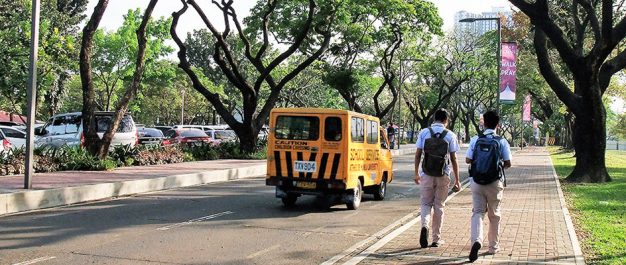
A paradise for pedestrians
Dinna Louise C. Dayao is an independent journalist whose reporting on road safety issues affecting children has been supported by a grant from the Pulitzer Center on Crisis Reporting. She shares some of her experiences with Child in the City.
Walking in Metro Manila is no walk in the park. The too-few sidewalks are dirty, cracked, and narrow. There is a dearth of shady trees to shield people from the hot sun or rain and to buffer them from cars and traffic. As vendors and motor vehicles encroach upon the sidewalks, people on foot often walk on the carriageway itself and risk getting hit by motor vehicles.
As a result, walking in the megacity can be fatal. More than 57,877 persons on foot were injured or killed in Metro Manila from 2005 to 2015, says Thinking Machines. Pedestrians made up 46.2% of Metro Manila’s 4,024 road fatalities since 2005,” reports the data science consultancy. “That’s more than the number of drivers (39.8%) or passengers (14%) that were killed. “In the megacity, there are a few areas where people on foot can feel safe. The Ateneo de Manila University in Quezon City is one of them.”
Since 2010, the school’s administrators and staff have been working together to make pedestrian safety a priority on the campus. In that year, Ateneo’s campus safety and mobility office audited the facilities for walking on campus. Then Fr. Jose Ramon T. Villarin, SJ, president of the Ateneo de Manila University, convened the Ateneo Traffic Group in 2011. “We will need sharp minds and resolute wills to design a new framework for campus mobility,” he wrote in a memo.

(Photo Courtesy of Dinna Louise C. Dayao)
The group’s members reviewed the university’s policies on traffic management and identified areas for improvement. The campus safety and mobility office carried out the group’s recommendations. Here’s how the two offices turned the Ateneo campus into a paradise for people on foot.
They reduced speed limits
Speed kills. The faster a motor vehicle is running, the greater the likelihood of a road crash and the more severe the crash. “It was a speeding van that ended the life of Ateneo student Julian Carlo Miguel C. Alcantara in 2009.” The boy, nicknamed “Amiel,” was reportedly crossing the street on campus, with his nanny and a sibling, when the motor vehicle hit him. The impact was enough for the boy to sustain severe head injuries, which led to his death. It reportedly shattered both of the nanny’s legs.
Charges of reckless imprudence resulting in homicide and serious physical injury were filed against the woman who was driving the van. The trial is ongoing.
In 2009, the speed limit on campus was 40 kilometers per hour (kph), reports Josephy Almosera. “After Amiel’s death, we lowered it to 30 kph,” says the assistant director of Ateneo’s campus safety and mobility office. This conforms to the World Health Organization’s recommended speed limit of 30 kph in school areas to keep children safe.
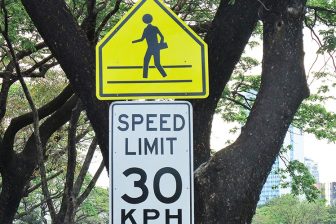
(Photo Courtesy of Dinna Louise C. Dayao)
To reduce the speed of motor vehicles and to allow pedestrians to cross safely, the campus safety and mobility office placed speed bumps before major pedestrian lanes. In some cases, the office consolidated pedestrian lanes into a properly designed and constructed speed table. The speed table prevents motorists from going fast and keep people on foot safe. Since speed was reduced on campus, no one has been injured or has died in a road crash, says Michael Canlas. He is the director of the campus facilities management office.
They made walking safe and fun
Almosera surveyed the school’s sidewalks in 2010. “I looked for areas that needed improvement,” he says. After walking 11 routes that covered 8.3 kilometers of sidewalks, he found plenty. In some places, the sidewalks were only about a meter wide. Some of them were unpaved; a few had protruding tree roots and rocks, which could trip the person on foot. Worst of all, the sidewalks were not connected or continuous.
“The child tended to keep crossing the street because there were unpaved paths on one side and a paved sidewalk on the other side,” he says. Today, there is a 10-kilometer network of sidewalks on campus. The sidewalks have been widened to 2.5 meters, says Marcelino Mendoza. He heads the campus safety and mobility office.
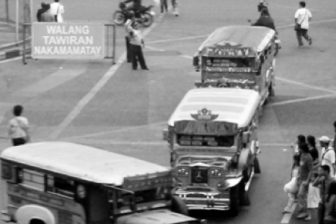
(Courtesy of Ateneo School of Government)
Mendoza has seen that if you build and maintain facilities so that people can safely walk, more people will walk. “Students used to drive from one building to another,” he says. “Now they walk.”
Ateneo’s connected sidewalks have made the campus a “friendly” one, says Canlas. “Students and guests alike can walk around and appreciate the old buildings and heritage trees within the campus.”
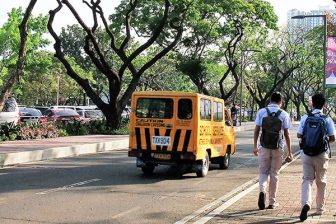
(Photo Courtesy of Dinna Louise C. Dayao)
They trained guards to manage the movement of people and vehicles
Almosera’s 2010 survey showed that there were 49 guards involved in traffic management. Only 31 of them were trained to manage the movement of people and motor vehicles on campus. So Ateneo requested the Metropolitan Manila Development Authority to train all guards in traffic management.
Today, the guards keep the children safe as they cross the streets. They also keep an eye on erring motorists; they can issue tickets for violations such as driving over the 30 kph speed limit and failure to give way to pedestrians on pedestrian lanes. Each violation carries a penalty of 3,000 pesos.
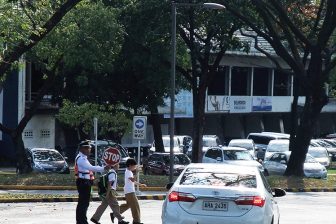
(Photo Courtesy of Dinna Louise C. Dayao)
This article was first published in the UN Global Road Safety Week website. Here’s the original article.




